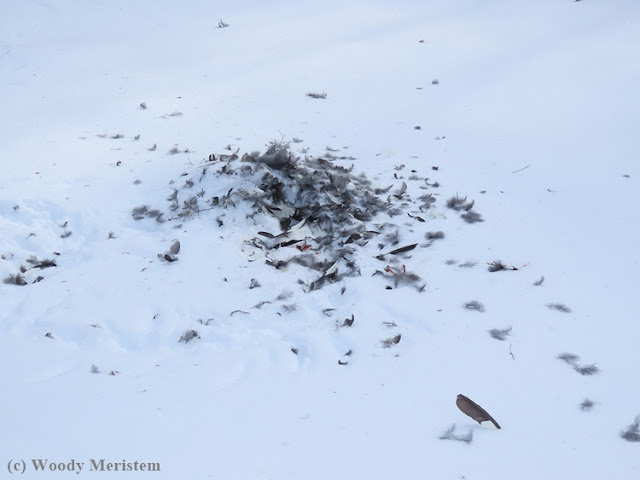The first clue was a feather in a ski track on the old road. The feather could have been easy to ignore because birds lose feathers for many different reasons –
A short distance further along, the road passes an old borrow pit where fill material had been removed in the past; in the middle of the clearing in the Big Woods formed by the borrow pit was a large mass of feathers –
For a life-long nature snooper this called for an investigation. There were no tracks on the snow-covered ground that led to the pile of feathers, at least there weren’t until I walked over to take a better look and left my own tracks there.
Here's a closer look at the feathers which were on and around a slightly elevated mound. The mound is a clue to the killer's identity –
To
set the stage a bit:
The ground had been bare in the Big Woods, but beginning the afternoon of the 16th through the morning of the 17th the Big Woods received 22-24 inches of snow. The following days were cold, but the 22nd was much warmer; between the snow compacting, sublimating and melting there was only about nine inches on the ground on the 23rd when I found the feathers.
The feathers were the key to the identity of the deceased, there were some red feathers –
And scattered primary feathers from the wings –
The primary feathers were the key to determining that the deceased was a pileated woodpecker, age and sex undetermined.
A lot of feathers were on top of the snow and apparently none were below the surface. So, the death must have occurred after it stopped snowing on the 17th, but that didn’t tell us much. On the 20th there was a fine dusting of snow, but there was no snow on top of the feathers. The temperature was barely above freezing until the afternoon of the 22nd, when it was partly sunny and in the mid-40s for several hours, a few of the black feathers had sunk a short way into the snow or settled into old depressions.
The night of the 22nd was below freezing and the snow had a slight crust into which some of the feathers had lightly frozen. So, it appears that the deed was done early on the 22nd.
Now we’ve determined the identity of the deceased and the date and time of death, it just remains to identify the killer. In several areas around the pile of feathers there were wing marks in the snow –
Those wing marks narrow it down to an aerial predator – a hawk or an owl. Pileated woodpeckers aren’t nocturnal; in fact, like all woodpeckers, they spend nights in a tree cavity. That reduces the odds of the killer being an owl as does the large quantity of feathers removed after the woodpecker was killed, owls usually only remove the largest feathers before dining –
So the killer was almost certainly a hawk that caught the woodpecker as it was flying across the clearing. It probably wasn't a red-tailed hawk nor a red-shouldered hawk since neither is fast or agile enough to easily catch a woodpecker in flight. That leaves us with either a goshawk or perhaps a very large Coopers hawk as the probable killer. Since goshawks have nested in the surrounding forest and the smaller Coopers hawk would be less likely to attack a bird as large as a pileated woodpecker, the deed was probably done by a goshawk. Goshawks, like this immature, are the largest of the bird-eating hawks, the Accipiters –
Accipiters are fast and agile and like to carry their prey to an elevated perch (remember the slight mound?). Similarly, the crow-sized pileated woodpecker is the largest of the North American woodpeckers –
Thus we can deduce the probable identities of the protagonists in this woodland drama. This is not a mystery worthy of Sherlock Holmes nor is it a murder mystery, it’s not even the story of a crime – it’s just how a pileated woodpecker died and a hawk got a meal.
Note – Predators are not “vicious”, “cruel”, “bloodthirsty” or any of the similar adjectives that have been applied to them over the centuries. They are no different than the robin eating the earthworm, the warbler eating the caterpillar nor those of us who enjoy a turkey dinner on Thanksgiving Day. They’re doing what they evolved to do and could no more change how they obtain a meal than we could stop the ocean’s tides.




















